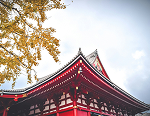Fukui City, the capital of Fukui Prefecture, is a serene destination that combines cultural heritage with scenic beauty. The city features the historical Fukui Castle Ruins and the impressive Eiheiji Temple, a 13th-century Zen monastery that continues to serve as a training center. Visitors can also enjoy peaceful strolls through Yokokan Garden and explore local history at the Fukui City Museum of Cultural History. Additionally, the city is a gateway to the renowned Fukui Prefectural Dinosaur Museum in nearby Katsuyama, making it a perfect base for family and educational tourism.

Fukui
Overview
Fukui, a prefecture on the Sea of Japan, is famed for its rugged coastline and historical sites. The Tojinbo Cliffs, with their dramatic, wave-carved formations, are a popular natural attraction. Fukui is also home to Eihei-ji Temple, a serene Zen monastery surrounded by forests. The Fukui Dinosaur Museum, one of the world’s top dinosaur research centers, is a hit with families. Fukui is also known for its delicious Echizen crab and soba noodles, attracting food enthusiasts from across Japan.
Areas


Tsuruga is a historically significant port city located on the Sea of Japan, serving as a cultural and international gateway for centuries. Its iconic Tsuruga Red Brick Warehouses have been transformed into charming cultural spaces and cafes. Kehi Jingu Shrine, with its massive wooden torii gate, is one of Japan’s most revered shrines. Tsuruga also holds a unique place in history for welcoming Jewish refugees during WWII, commemorated at the Port of Humanity Tsuruga Museum. In addition, visitors can relax at Kehi-no-Matsubara, a pine grove beach designated as one of Japan’s top 100 scenic coasts.



Katsuyama is a charming inland city surrounded by mountains and nature, best known for the Fukui Prefectural Dinosaur Museum, one of the world’s leading paleontology museums. Visitors can experience real fossil excavation nearby and explore dynamic exhibits with life-sized dinosaur models. The city also offers access to Mount Hakusan, a sacred and scenic mountain ideal for hiking and photography. During winter, Katsuyama transforms into a snowy wonderland with ski resorts and hot springs. Historical sites such as Heisenji Hakusan Shrine add a cultural touch to this nature-filled destination.

Sabae is a specialized city recognized for producing over 90% of Japan’s eyeglass frames. Known for its outstanding craftsmanship, the city offers factory tours and hands-on workshops where visitors can create their own custom eyewear. Sabae is also home to Nishiyama Park, a spacious green area ideal for family outings and cherry blossom viewing, as well as a small zoo that houses the popular red pandas. The Megane Museum, dedicated to the history and innovation of eyewear, further highlights Sabae’s identity as Japan’s eyewear capital.


Echizen is a historic city known for traditional crafts such as Echizen washi (handmade Japanese paper) and Echizen cutlery. Visitors can tour workshops and try papermaking or blade forging themselves. The city is also home to temples like Manpukuji and the serene Murasaki Shikibu Park, honoring the famed author of The Tale of Genji, who once lived here. Every autumn, the Echizen Festival lights up the town with cultural performances and floats, making it a vibrant destination blending art, culture, and tradition.

Sakai City boasts stunning coastal scenery and historical significance, especially with the iconic Tojinbo Cliffs—rugged basalt columns that drop dramatically into the Sea of Japan. Visitors can enjoy boat tours or hike along the coastline. The Echizen Matsushima Aquarium and Mikuni Port’s retro townscape offer great family attractions. Moreover, Maruoka Castle, one of Japan’s oldest surviving castles, offers panoramic views and insight into feudal-era architecture. This blend of natural beauty and historical depth makes Sakai a rewarding destination.







Wakasa, nestled between mountains and sea, is rich in natural resources and historical depth. Known as a key point on the ancient Saba Kaido (Mackerel Road), it served as a vital cultural and food route to Kyoto. Visitors can explore the scenic Mikata Five Lakes, designated as a Ramsar site, ideal for kayaking, birdwatching, and lakeside strolls. Wakasa also features historical temples like Jinguji and cultural sites preserving local heritage. Its traditional culinary culture, especially grilled mackerel and seasonal seafood, adds flavor to this peaceful coastal retreat.